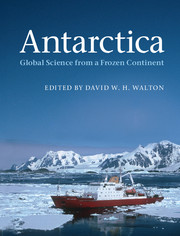Book contents
- Frontmatter
- Contents
- List of contributors
- Introduction
- 1 Discovering the unknown continent
- 2 A keystone in a changing world
- 3 Ice with everything
- 4 Climate of extremes
- 5 Stormy and icy seas
- 6 Life in a cold environment
- 7 Space science research from Antarctica
- 8 Living and working in the cold
- 9 Scientists together in the cold
- 10 Managing the frozen commons
- 11 Antarctica: a global change perspective
- Appendix A Visiting Antarctica
- Appendix B Further reading
- Acknowledgements
- Index
9 - Scientists together in the cold
Published online by Cambridge University Press: 05 March 2013
- Frontmatter
- Contents
- List of contributors
- Introduction
- 1 Discovering the unknown continent
- 2 A keystone in a changing world
- 3 Ice with everything
- 4 Climate of extremes
- 5 Stormy and icy seas
- 6 Life in a cold environment
- 7 Space science research from Antarctica
- 8 Living and working in the cold
- 9 Scientists together in the cold
- 10 Managing the frozen commons
- 11 Antarctica: a global change perspective
- Appendix A Visiting Antarctica
- Appendix B Further reading
- Acknowledgements
- Index
Summary
The Antarctic is proof that great things can be achieved through collaboration.
Richard FifieldEarly steps in Antarctic collaboration
Scientific work has always been conducted at a range of scales from the individual to enormous international consortia, where the equipment needed or the questions being asked are bigger than any one person or nation can manage. This is particularly true for those scientific questions that cross geographic boundaries or are at the scale of whole ocean basins, whole continents or of the planet itself and its relation to other planetary bodies. Antarctica is one of these large-scale challenges for science.
The International Geophysical Year (IGY) of 1957–58 brought together many thousands of men and women from all over the world to take part in a common undertaking on a scale never before attempted in science. It was organised by scientists, yet supported by governments. It was a civilian exercise, yet logistically supported in many countries by the armed forces. It was watched over and coordinated, but not organised by, an international institution, yet relied on the collaboration of scientists from 67 countries. Despite its apolitical nature, its cooperative spirit contributed in no small way to the diplomatic framework for later negotiations leading to such developments as the Antarctic Treaty (1961), the Test Ban Treaty (1963) and the Space Treaty (1967).
- Type
- Chapter
- Information
- AntarcticaGlobal Science from a Frozen Continent, pp. 253 - 272Publisher: Cambridge University PressPrint publication year: 2013



